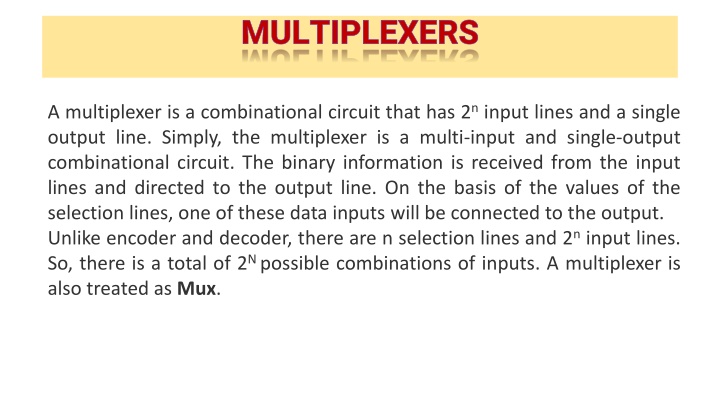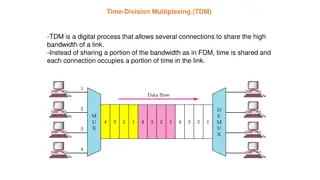
Understanding Multiplexers in Combinational Circuits
Learn about multiplexers, a key component of combinational circuits that route binary information based on selection lines. Dive into the workings of 2:1, 4:1, and 8:1 multiplexers with their logical circuits and truth tables.
Download Presentation

Please find below an Image/Link to download the presentation.
The content on the website is provided AS IS for your information and personal use only. It may not be sold, licensed, or shared on other websites without obtaining consent from the author. If you encounter any issues during the download, it is possible that the publisher has removed the file from their server.
You are allowed to download the files provided on this website for personal or commercial use, subject to the condition that they are used lawfully. All files are the property of their respective owners.
The content on the website is provided AS IS for your information and personal use only. It may not be sold, licensed, or shared on other websites without obtaining consent from the author.
E N D
Presentation Transcript
MULTIPLEXERS A multiplexer is a combinational circuit that has 2ninput lines and a single output line. Simply, the multiplexer is a multi-input and single-output combinational circuit. The binary information is received from the input lines and directed to the output line. On the basis of the values of the selection lines, one of these data inputs will be connected to the output. Unlike encoder and decoder, there are n selection lines and 2ninput lines. So, there is a total of 2Npossible combinations of inputs. A multiplexer is also treated as Mux.
2 2 1 Multiplexer 1 Multiplexer: : In 2 1 multiplexer, there are only two inputs, i.e., A0and A1, 1 selection line, i.e., S0and single outputs, i.e., Y. On the basis of the combination of inputs which are present at the selection line S0, one of these 2 inputs will be connected to the output. The block diagram and the truth table of the 2 1 multiplexer are given below.
Truth Table: Logical circuit of the above expression is given below: The logical expression of the term Y is as follows: Y=S0'.A0+S0.A1
41 Multiplexer: In the 4 1 multiplexer, there is a total of four inputs, i.e., A0, A1, A2, and A3, 2 selection lines, i.e., S0and S1and single output, i.e., Y. On the basis of the combination of inputs that are present at the selection lines S0and S1, one of these 4 inputs are connected to the output. The block diagram and the truth table of the 4 1 multiplexer are given below.
Logical circuit of the above expression is given below: Truth Table: The logical expression of the term Y is as follows: Y=S1' S0' A0+S1' S0A1+S1S0' A2+S1S0A3
81 Multiplexer: In the 8 to 1 multiplexer, there are total eight inputs, i.e., A0, A1, A2, A3, A4, A5, A6, and A7, 3 selection lines, i.e., S0, S1and S2and single output, i.e., Y. On the basis of the combination of inputs that are present at the selection lines S0, S1,and S2, one of these 8 inputs are connected to the output. The block diagram and the truth table of the 8 1 multiplexer are given below.
Logical circuit of the above expression is given below: Truth Table: Y=S0'.S1'.S2'.A0+S0.S1'.S2'.A1+S0'.S1.S2 .A2 +S0.S1.S2'.A3+S0'.S1'.S2A4+S0.S1'.S2A5 +S0'.S1.S2.A6+S0.S1.S3.A7
8 1 multiplexer using 41 and 21 multiplexer We can implement the 8 1 multiplexer using a lower order multiplexer. To implement the 8 1 multiplexer, we need two 4 1 multiplexers and one 2 1 multiplexer. The 4 1 multiplexer has 2 selection lines, 4 inputs, and 1 output. The 2 1 multiplexer has only 1 selection line. For getting 8 data inputs, we need two 4 1 multiplexers. The 4 1 multiplexer produces one output. So, in order to get the final output, we need a 2 1 multiplexer. The block diagram of 8 1 multiplexer using 4 1 and 2 1 multiplexer is given below.





